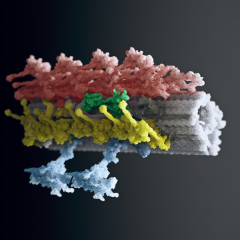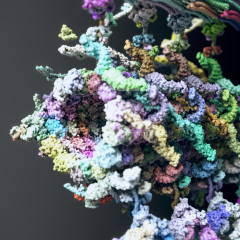Structure and Function of the Axoneme
Central to all cilia is the axoneme, one of the most geometrically complex and structurally conserved macromolecular machines found in nature. The prototypical axoneme of a motile cilium has a “9+2” architecture where nine peripheral doublet microtubules (DMTs) encircle a central pair of singlet microtubules, with each outer DMT bound by dynein motors and their regulatory complexes. During ciliary beating, axonemal dyneins docked onto one DMT interact and pull against a neighboring DMT through their motor domains to induce microtubule sliding, which eventually leads to bending. To generate the ciliary waveform, axonemal dynein activity alternates between DMTs on opposite sides of the axoneme via a hypothesized mechanoregulatory pathway. The structure of the axoneme and how it generates motility has fascinated scientists for decades, but it is only now through the application of cryo-EM that we are beginning to understand this beautiful structure in atomic detail.
New insights into axoneme structure
Our approach has been to biochemically deconstruct the axoneme in vitro into individual axonemal complexes or microtubules suitable for structure determination using cryo-EM. Using the biciliated model organism Chlamydomonas reinhardtii, our approaches have allowed us to successfully resolve structures of DMTs and their associated microtubule-inner proteins (MIPs), the axonemal dyneins (ODAs) that provide most of the power necessary for motility, the mechanoregulatory radial spoke complexes, and the central pair microtubules. These studies - often in collaboration with Dr. Rui Zhang and Dr. Susan Dutcher at Washington University in St. Louis - have revealed new insights into the principles that guide the assembly of the axoneme and the mechanisms that regulate ciliary motility. In 2023, we consolidated our structures into a near-complete atomic model of the modular repeat of the axoneme.
Using methods developed for studying Chlamydomonas axonemes, we are now exploring mammalian and human axonemes from respiratory epithelia and other human tissues, to better understand the evolution of the axoneme and species-specific adaptations. These structures are also helping to improve our understanding of the possible causes of human ciliopathies with impaired ciliary motility.

